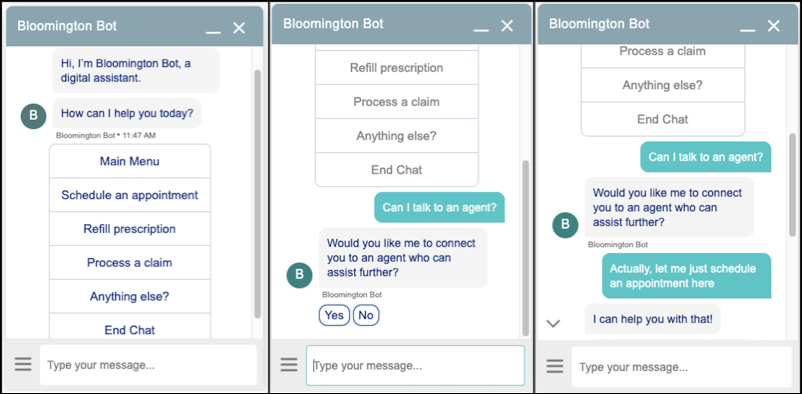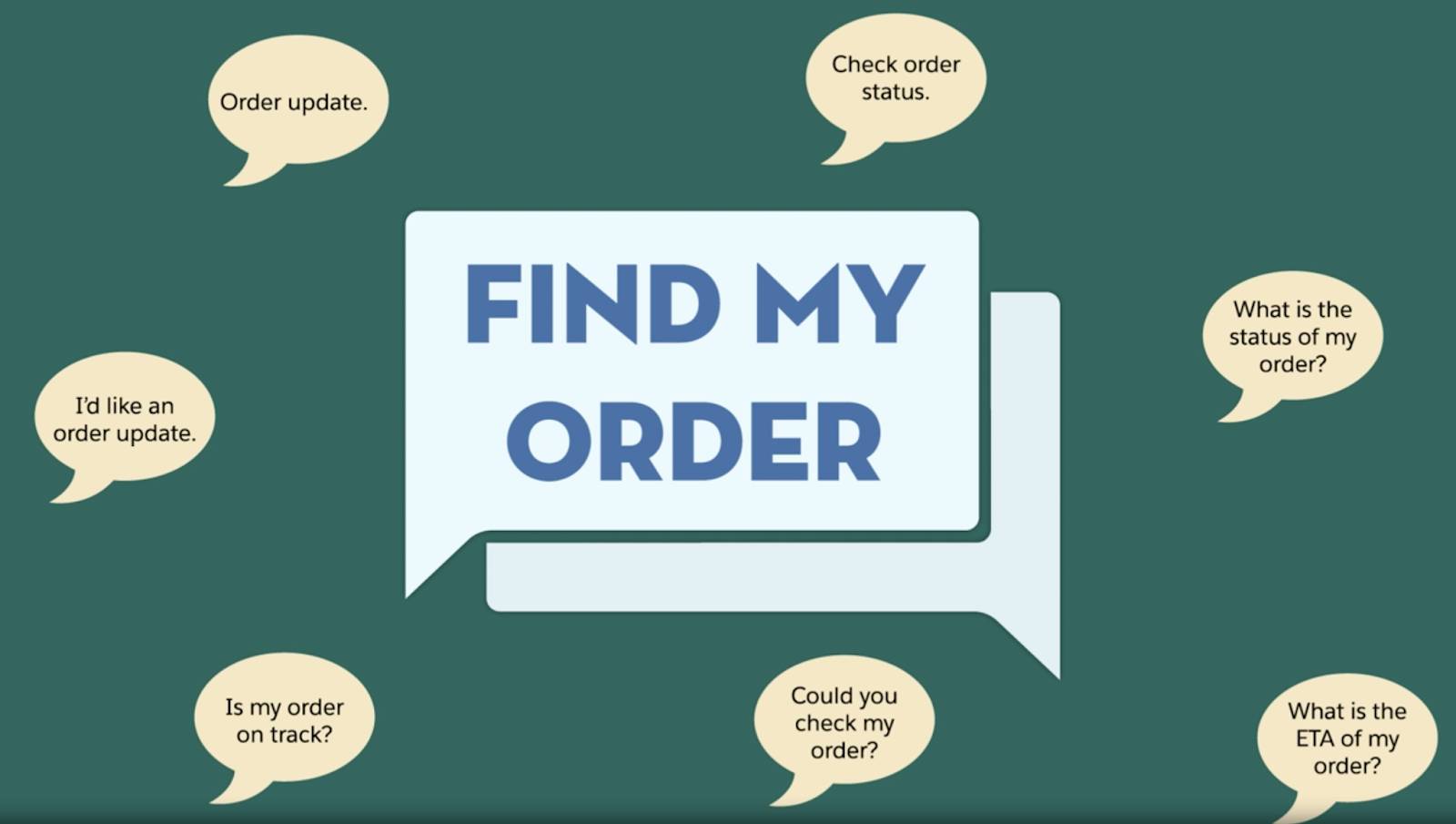Choose the Right Use Case for Your Business
Learning Objectives
After completing this unit, you’ll be able to:
- Describe how a bot aligns with your business goals.
- Define the jobs your bot will perform.
- Assemble a team to implement Einstein Bots.
- Identify what kind of bot is best for you.
Align Your Bot with Your Business Goals
You just followed Harryette and team as they made some important decisions about implementing a bot. In this unit, we walk you step by step through each consideration.
Before you begin the bot-building process, first think about what exactly you want your bot to do for your company and how it can achieve these goals.
Some admins might build a bot to meet a larger company objective, such as Bloomington Caregivers’s goal of handling more customer support cases without hiring additional staff. Whatever the motive may be, your company’s goals should always be kept in mind when building your bot.
In order to best align your bot with your goals, revisit the business outcomes that motivated your company to seek out a bot. Then make a short list of key performance indicators (KPIs) that you can use to measure your bot’s success. We recommend keeping the list to three KPIs to start. Common KPIs our customers use to measure their bot’s success include:
- Cases deflected
- Customer satisfaction ratings
- Leads generated
- New enrollments within the bot
- Product purchases within the bot
Now that your business outcomes and KPIs are clearly in view, it’s time to determine how your bot can help achieve these goals.
Define the Jobs Your Bot Will Perform
This is the part where you pick the appropriate use cases for your bot. If you don’t know where to start, try identifying the top intents your customers might have. For example, Bloomington Caregivers anticipated an influx of prospective patients on the site and phone lines, so Harryette checked with the customer support manager to identify the two main reasons that customers call. They are: to enroll a new patient at Bloomington Caregivers and to ask general questions.
To expedite both of these processes, Harryette chose appointment scheduling and FAQ handling as two of the top use cases for the Bloomington Bot. As for Bloomington Caregivers’s existing patients, she decides to use the bot to efficiently handle cases related to prescription refills, claims processing, and programs/benefits eligibility.
If you’re like Harryette and need to start a bot project from scratch, these use cases can help guide the rest of your implementation. If you don’t have a use case picked out just yet, exploring this module can give you a sense of how a bot might fit into your business and what the adoption process looks like. For more inspiration, you can always revisit the table of common use cases in Unit 1.
Assemble a Team to Build Your Bot

Before you implement your use cases, remember this: Behind every successful bot is the all-star team that builds it. That’s why it’s crucial to define who your stakeholders are and the role each one will play in developing and maintaining the bot. Every team that brings a bot into production usually includes three primary roles (these can overlap depending on how your company is structured).
- Executive stakeholders, who determine the bot requirements based on company strategy and plan for bot growth.
- Subject matter experts (SMEs), who deliver the insights and content that the bot uses to interact with customers.
- Admins or developers, who build the bot in the Bot Builder.
Your all-star bot team might include product managers, Salesforce admins, developers, and others, such as Harryette, who serves both as a manager and an admin.
Executive stakeholders can come in many forms. Perhaps they’re a CEO with high-level company goals, one of which you think you can help achieve with an Einstein Bot. Maybe they’re the head of your department, or a board member of the company. The important thing to remember is that they should set the business goals that will guide the bot-building process.
While executive stakeholders define goals for the bot, admins, developers, and SMEs are the stars of the show. Together, they bring the bot to life and keep it alive over time.
SMEs include content specialists or customer support staff who understand the customer and how to interact with them. Admins and developers are Salesforce-savvy team members who know how to put the bot together and make it work. As admins and developers build the bot, they can look to SMEs for guidance on how to tailor features to the customer, and SMEs can focus on crafting a cohesive customer experience within the bot through conversation design and more.
Let’s walk through an example of how these roles work together.
- CEO: “I want us to handle more customer support cases at a faster rate, so we can convert more customers and increase satisfaction scores.”
- Salesforce admin: “A bot can help us achieve these goals while saving costs. If we implement Einstein Bots into our customer support strategy, I can build it with the help of a team.”
- SME: “I’m familiar with our company knowledge base and know how our customer support team works. I can provide the relevant information we need to include in the bot.”
Which Type of Bot Is Best for Your Needs?
With the help of your newly assembled team, it’s now time to begin thinking about what type of bot is best for your company’s needs. No, we’re not talking personality types (yet). We’re thinking bigger picture types, like these:
- Menu-based bots allow users to select a path based on a menu of options within the chat. These bots are easy to set up, deliver high value on low-level tasks such as password resets, and help you deliver a curated experience to the customer.
- Natural language processing (NLP) bots can interpret free text using NLP. Users can choose where an NLP bot moves, so they have more control over the experience. Also, NLP bots can interpret multiple pieces of information within one phrase, so they can complete certain tasks in fewer steps.
- Hybrid bots use menu-based methods and NLP methods at the right time to create a blended experience. A menu helps customers understand what the bot can do. And NLP helps the bot sound smarter and more conversational.

Before you begin comparing these bot types, keep in mind that they are not mutually exclusive, so you don’t have to choose between them right away. They exist more on a spectrum, with NLP being the differentiating factor that can be adjusted over the course of your bot’s life. So…
What Exactly Is NLP (and NLU)?
People often think of artificial intelligence (AI) when they hear “chatbot,” but not all bots can respond flexibly (like a human) the way AI can. The ones that can, use natural language processing (NLP) or natural language understanding (NLU) to interpret user inputs and respond appropriately. In the world of chatbots, we call these user inputs utterances, and different utterances that signal the same request make up an intent.

NLP bots learn how to respond through intent models, which contain a range of utterances organized by intent. That’s where the AI component of chatbots comes into play. NLP bots learn from an intent model and, given enough quality data, can eventually draw their own conclusions based on what they’ve learned.
In the beginning, your bot may only be able to correctly identify a customer’s intent if it receives an utterance that matches exactly what the intent model indicates. But eventually it will be able to recognize more ways that users might phrase the same intent. Because NLP bots learn from the data you give them, it’s crucial that you provide them with complete and high-quality intent models. To start an intent model, our bots require three to five intents.
If you know that you want a strictly menu-based bot, then you don’t have to worry about NLP. Menu-based bots are great for automating common requests, easier to implement than NLP bots, and they give customers a sense of what they can do by providing them with clear options off the bat.
NLP or hybrid bots are more versatile and conversational but take more resources to set up and maintain. If you choose to create a menu-based bot and later change your mind, don’t worry. It’s entirely possible to add NLP to your menu-based bot further down the line.